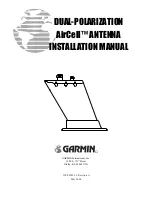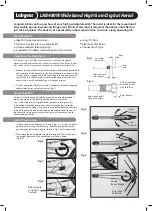
DSE945LYRM Rev 10/20
Directive Systems & Engineering
2702 Rodgers Terrace
Haymarket, VA 20169-1628
www.directivesystems.com
703-754-3876
9cm Loop Yagi (Rear Mount), Model DSE945LYRM
SPECIFICATIONS
Frequency range:
3.40 to 3.48 GHz
Gain:
20 dBi
Number of elements:
45
3 dB Beamwidth
Boom length:
60 inches
(E plane):
16º
Boom diameter:
0.5 inches
F/B ratio:
>20 dB
Mast diameter:
1 1/2 inches max
Maximum Power:
100 W average
Weight: (assembled)
1.5 pounds
Stacking distance: 9
inches’ vertical
Connector: Type-N female
9.8
inches’ horizontal
Note: All hardware is Stainless Steel unless otherwise noted.
BEFORE INSTALLING YOUR NEW ANTENNA, PLEASE BE SURE
TO READ THE ENCLOSED WARNING PAMPHLET.
ASSEMBLY INSTRUCTIONS
1)
Unpack the antenna and locate the hardware package. Antennas are shipped in two
sections. Assemble the boom by removing the last three directors from the rear (longer) boom
piece. These loops are D22, 23 &24, and are of similar size. Insert front boom piece into rear
boom piece so that the orientation lines are aligned. Now insert D22 thru 24 into their
respective mounting holes and tighten.
2)
Straighten any misaligned elements and re-tighten if necessary.
But do not touch R1,
DE or D1, as these have been factory set for minimum SWR.
3)
Attach the boom to mast plate to the boom with the hardware provided. Install the U-bolts
so that the mast comes up directly under the boom.
4)
Attach the feed line, and tape it to the bottom of the boom. The connector should be sealed
with electronic grade RTV or equivalent.
5)
The antenna SWR has been adjusted at the factory for less than 1.5:1 VSWR.
Additional tweaking can be accomplished by changing the shape of the driven element slightly
and by adjusting the distance between the driven element andR1 and D1. R1 is the reflector
closest to the driven element.
NOTE:
Do not attempt this adjustment unless the proper
equipment and qualified personnel are available.




















